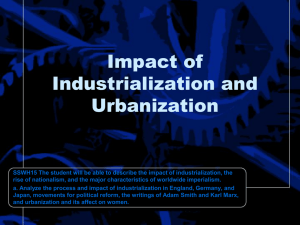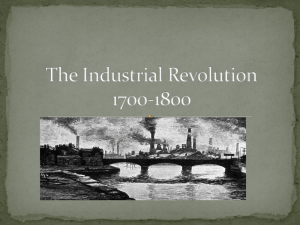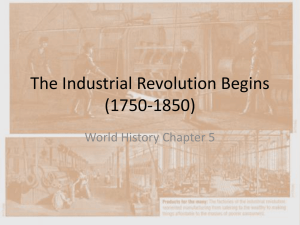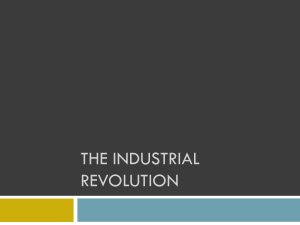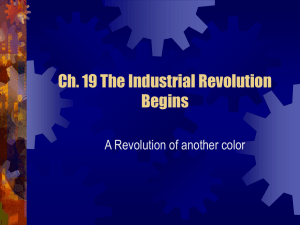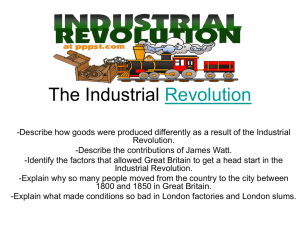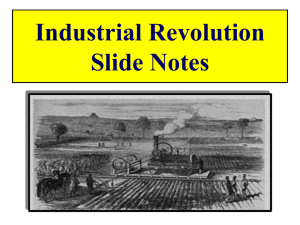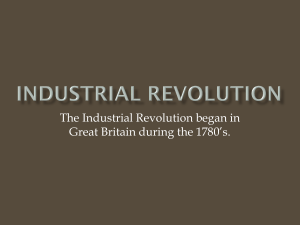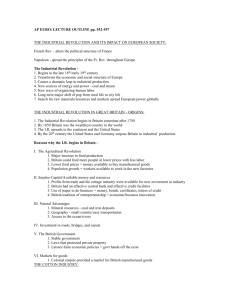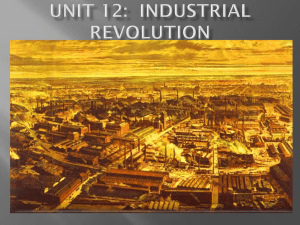113 chapter 21 section 1 A New Kind of Revolution
advertisement
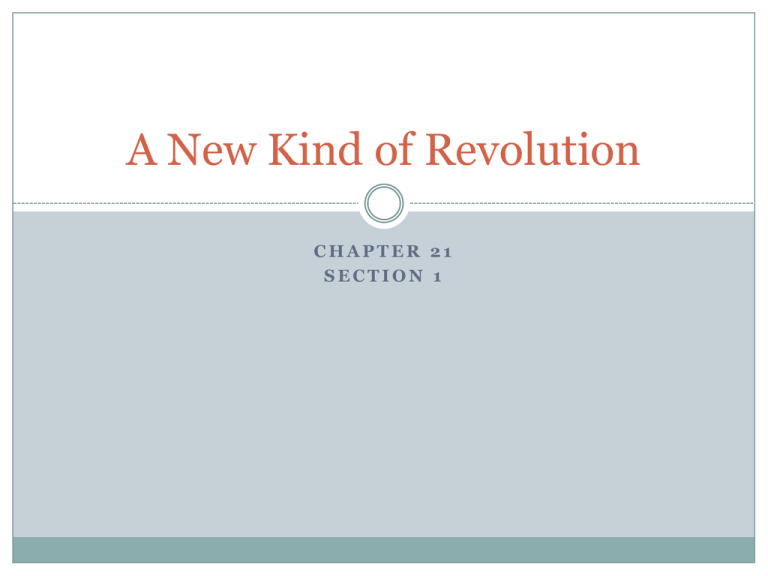
A New Kind of Revolution CHAPTER 21 SECTION 1 Key Terms Industrial Revolution Jethro Tull Enclosure movement Richard Arkwright Factors of production James Watt Cottage industry Robert Fulton Factory Industrialization A Revolution in Great Britain Humans and animals were main energy source People began to develop water and steam power Industrial Revolution-the era when the use of power driven machines was developed Factors for Success Exploration and colonization-provided raw materials such as cotton and fiber Colonies became new markets Sea power brings in raw material and send out manufactured goods because of strong navy Factors of Success Political stability-1700’s at home the country was a peace, commerce thrived Government supportParliament passed laws that favored business Growth of private investment-private funding for research and development Agricultural Factors Most of research took place on farms Jethro Tull-1701 invented the seed drill made planting grain more efficient Improved livestock breeding Potatoes were developed Agricultural Factors Increased food supply Population grew Wealthy landowners combined fields to create large farms Enclosure developmentthe fencing in of large farms Threw countless farmers of their fields Moved to the city for jobs Britain’s Big Advantage Factors of productions- land, labor and capitol Land- means all of place’s natural resources Coal to burn as fuel Iron to make steel Water was the most important Streams and rivers turned waterwheels and generated power Britain’s Big Advantage Waterways provided transportation between mines, factories and markets Mid 1700’s had 1000 miles of canals Grew to 4,000 by 1800 Deep water ports for long distance shipping Britain’s Big Advantage Labor- had a growing population Thousands lost their farmland Entire families would go to work in an industry Capitol-funds investment for business People with money to spend People with skills inventors A Revolution in Textiles Began with textile industry Cottage industry- a craft occupation performed at home Industrialization-the process of changing to power driven machinery A New Way to Make Cloth Most fabric made of wool or cotton Wool increased because of enclosure movement Shipments of cotton came from the colonies Slave labor made cotton farming more profitable Great Britain bought more American cotton A New Way of Making Cloth Pulling seed from cotton by hand was time consuming Eli Whitney invented the cotton gin (machine) Fiber was then spun into yarn James Hargreaves invented the spinning jenny A New Way of Making Cloth James Arkwright- made a machine that spun stronger, thinner thread Thread woven into fabric Use to be done a t home Power Loom-larger faster weaving system Cloth-making in Factories New weavers too big for the home Factory- a building that houses industrial machines Needed supplies of power Arkwright built the water frame spinning system Went from 50,000 bolts of cloth to 400,000 in thirty years Steam Powers the Revolution 1712 first steam engine 1800 - 500 of James Watts machines Put to use in textile industry Factories did not have to be built near water Located where there was fuel and workers Steam Powers the Revolution Steam used for transportation Richard Trevithick- used steam power for a locomotive Robert Fulton used it for a steamship 1807 Clermont operated on the Hudson River Steamships replace sailing ships Coal for British Steam Engines Steam engines require a lot of fuel Wood was scarce Had a large supply of coal Coal mining grew as steam power grew 1800 Great Britain produced 80% of Europe's coal Coal for British Steam Engines Factories built near coal mines Towns grew as factories and homes were built Miners families experienced tragedies Explosions Coal dust Collapsing shafts Hard labor Children slid down narrow shafts to pick coal Industrialization Spreads Western Europe, Americas Asia and Africa did not industrialize in the 1800’s Industry and the West Western countries individual freedom a significant force People enjoyed political liberty People could compete Western societies competition as good Wealth and fame was the reward Industry and the West Westerners exploited other countries to compete Competed to improve inventions or processes Industry Comes to America Britain outlawed the export of certain machines Forbid skilled craftsman from leaving the country 1760- 1830 Industrial Revolution mainly in Great Britain Industry comes to the America United States one of the first places to benefit from Industrialization 1791 Alexander Hamilton (Secretary of the Treasury) Industrialization would help the United States gain economic independence Wanted government to bribe British citizens to brink knowledge to U.S. Industry Comes to America Samuel Slater came from Britain Built a model of the water frame in Rhode Island 1793 built Slater’s Mill In Pawtucket Rhode island Became the father of American industry Industry Comes to America Textile mill technology spreads Lowell Massachusetts becomes the jewel of American Industry Lowell’s mills were forty multistory buildings on a network of 6 miles of canals Industry Comes to America Lowell first all in one mill Took raw cotton to fiber to finished cloth Hired young single girls Provided good wages and clean housing 10,000 workers employed by 1850 Industry Spreads to Europe 1807 William Cockerill founded a textile factory in Belgium Political unrest delayed industrialization of France 1848 France becomes an industrial power Treaties helped drop trade barriers Industry in Asia Although today Japan is one of the more industrialized nations Took until 1868 for Industrial Revolution to take hold Meiji government came to power modernized the country Japan was ahead of its Asian neighbors
